|
| Author |
Message |
jcorrigan
Member
|
# Posted: 22 Apr 2012 06:30pm
Reply
Hello all, just thought I'd share my latest projects at the cabin and maybe help someone out with their solar setup. I bought a couple of those 30W panels at Cdn. Tire (on sale for about $100 bucks each). They're wired to four 6V 168 AH golf cart batteries wired in series and parallel. Bought them new, ordered in by our local mechanic for $75 each. Beware, these are HEAVY! They fit nicely into a plastic tote with a lid bought for about 20 bucks again at cdn tire. I've drilled holes in the side for ventilation and leave the entire thing next to the shed.
Once set up, I wired the cabin in 10-2 for a main line ending at the bedroom on the far side. I connected a 400W inverter to this for a bedside lamp and wireless iPhone speaker set. Off this 'main line' I ran some trunks in 12-2 for overhead lighting in the kitchen and a small freshwater marine pump to supply water pressure in the kitchen and pressure to a small tank-less hot water heater for an outdoor shower.
I use the cabin mainly on weekends and so far I have plenty of power. I've never run the batteries down past 11.9 yet over 3-4 days of use. Of course I'm not putting a big load on the system either.
The system seems to pick up about half a volt per day on cloudy days, more when the sun is beaming. Before leaving back to civilization on Sundays I pull the automotive fuse (20A) that I put in between the batteries and the line as a safety and let everything charge back up.
So far so good...I may look at adding a VAWT later just to add some juice. But I think I'll just enjoy flipping a switch to turn on lights for now. Any questions or comments fire away. I'm no expert by any means but I spent the winter watching a LOT of youtube vids and reading websites on the subject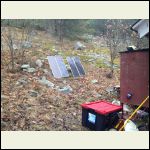
Panels and batteries
| 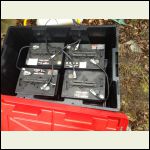
Battery Setup
| 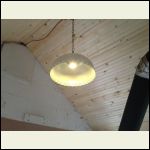
Retrofitted 12V LED lamp
| 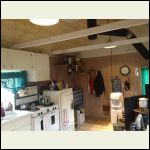
Lights on for safety ;-)
|
|
|
sparky1
Member
|
# Posted: 23 Apr 2012 07:40am - Edited by: sparky1
Reply
are you using 115 volts Lights or 12 volt CFL's ?
15 watt CFL's are Camco # 55-8030 got them at a RV dealer. $12.99
15 CFL's watts = 60 incandescent in brightness.
sparky1in s.va
oops---pictures hadn't shown up---see the led's now--
never mind
|
|
MtnDon
Member
|
# Posted: 23 Apr 2012 06:32pm - Edited by: MtnDon
Reply
Quoting: jcorrigan I've never run the batteries down past 11.9 yet over 3-4 days of use.
11.9 volts with no load? or under load?
11.9 volts is actually quite a low reading for a 12 volt system if there is no load or low load beinmg applied at the time of the reading. Sp Gr with a hydrometer is a more accurate method, FYI.
Here's a chart that illustrates both voltage readings and sp gr readings for lead-acid battery state of charge. Best battery life is achieved with never going below a 50% SoC.
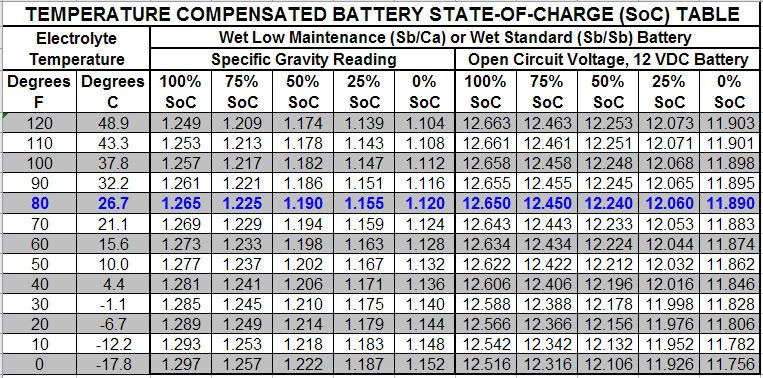
|
|
jcorrigan
Member
|
# Posted: 23 Apr 2012 07:23pm - Edited by: jcorrigan
Reply
Hmm...so perhaps more batteries are in order MtnDon? Like I said before I'm no expert...
That's with no load, and that's just what the cheap Cdn tire inverter tells me...guess I'll pick up a hydrometer this weekend and take some more readings - before and after!
Thanks for the tip, I appreciate the help!
Sparky - They're LED lights I made using the post here:
http://www.small-cabin.com/forum/3_985_0.html
They work great!
|
|
MtnDon
Member
|
# Posted: 23 Apr 2012 07:32pm
Reply
I'd say more PV module capacity is required. Ideally, a PV system should be able to recharge the system batteries with a day of whatever amounts to normal sunshine for the area. And ideally the batteries should not drop below 50% SoC, ever.
In a part time occasional use system the argument could be made for allowing the recharge time to extend over a couple or even three days. It's the deep discharge that will shorten the battery life considerably though.
The voltage meters built into a lot of inexpensive equipment may have some accuracy problems too. Definitely get a hydrometer, preferable one with a built in thermometer so you can easily take the temperature into account. A quality meter, like a Fluke, is always nice for accuracy, but temp corrected hydrometer readings are basically foolproof.
Also good to keep a record of the cell by cell readings taken over a period of time; months to years. That can help give early warning of cell deterioration.
|
|
jcorrigan
Member
|
# Posted: 23 Apr 2012 07:47pm
Reply
and just to clarify...don't think me stupid but seems to me that use of a hydrometer would mean I don't need to disconnect all the batteries to get a good reading? The hydrometer would indicate if I had a bad battery or maybe a loose connection somewhere that's leading to an uneven charge?
|
|
Sarge
Member
|
# Posted: 28 Apr 2012 02:29pm
Reply
11.9 volts on a 12volt system is a dead battery.
You do not have near enough PV for your battery bank friend.
10% of the battery bank amps is your PV amp minimum output.
Yes...leave your batteries connected.....but no load on them,then take your readings.
|
|
Sarge
Member
|
# Posted: 28 Apr 2012 02:30pm
Reply
Also.....I would equalize those batteries first chance I got.
|
|
|
jcorrigan
Member
|
# Posted: 29 Apr 2012 09:05am
Reply
Alright..seems I've got more work to do. Thanks a lot for all the input, I really appreciate it! Not want I wanted to hear but I'd rather fix the issues now than buy new batteries every year 
I'll keep you up to date on the progress and keep fine tuning it. This is a great resource from people who know what they're doing and don't mind helping the newbie!
|
|
Sarge
Member
|
# Posted: 29 Apr 2012 10:12am
Reply
Very very common mistake. Huge battery banks and lil bitty PV arrays.
Just throwing this out for thought.
Realize these smaller panels are very expensive and hardly ever meet minimum requirements outside throwing corn from a deer feeder or opening a gate. 30 watts for $100 is $3.33 per watt. Holy Moly!
Try 120 watt panels for $165 delivered. Now we are a third of the cost and 4 times the power output.
Just Google around. They are out there.
Good luck with your project. You do not have to spend a bunch of money to have reliable power. Just scale and shop 
|
|
jcorrigan
Member
|
# Posted: 29 Apr 2012 06:49pm
Reply
Now, do my panels all have to be the same wattage Sarge?
|
|
MtnDon
Member
|
# Posted: 29 Apr 2012 06:58pm
Reply
If they are in series they should be approximately the same voltage (Vmp). If they are in parallel they should be approximately the same amperage (Imp). Especially with an MPPT charge controller. In any event parallel or series ensure their combined output does not exceed the Voc or the Isc total rating.
|
|
Sarge
Member
|
# Posted: 29 Apr 2012 08:13pm
Reply
Yup^ MtnDon is right.
I have 120/125/135 watt panels in parallel in array#2, but they are within +/- 5% amperage output. Work great.
So no you cannot use 30 watt panels with a 120 watt panel in parallel going into the same charge controller.
But allow me to give you an out on your existing investment.
Have two controllers to one battery bank. Use your existing setup as array one and your new panels with another charge controller as array two.
Gives you redundancy, if you have any shading issues this is how I deal with it....two arrays....two controllers.....one battery bank.
So morning or evening (whatever) you have some shading both arrays are not affected.
Charge controllers (PWM) low amp(s) are not much money.
|
|
jcorrigan
Member
|
# Posted: 29 Apr 2012 09:22pm
Reply
Got it! Sarge looks like I gotta move to Texas to get a better price on panels...still bloody expensive up here in Canada!
|
|
Sarge
Member
|
# Posted: 30 Apr 2012 07:46am - Edited by: Sarge
Reply
Forgive my ignorance friend....is there special tax or import fees to have panels shipped from the USA to Canada?
I see 140 watt for $185, 100 watt panels for $135 and 80 watt for $106 this morning.
If you watch these guys they have free shipping and specials weekly.
http://www.solarblvd.com/Solar-Panels-&-Systems-Individual-Solar-Panels/c1_25/index.h tml
Email/call them and check out shipping charges to Canada....now you have me curious.
|
|
jcorrigan
Member
|
# Posted: 30 Apr 2012 03:12pm
Reply
Just seems to be the price we pay for living up here..too many middle men drive up the prices of everything. And that's not including our provincial/federal taxes. Couple of examples:
Canadian Tire
60W Solar Panel Kit: $399
URL
Costco (Like a Sams Club)
36W Solar Panel Kit: $189.99
URL
On top of these prices we have a 13% HST or 'harmonizing sales tax' added to these purchases. Most times when ordering items from the US we get charged Duty on the items too, depending on what they are.
The only issue I would have with ordering from the states would be if I needed to return the item(s) due to damage in transit. I don't know how much (if any) duty would be paid on items like that.
|
|
CabinBuilder
Admin
|
# Posted: 30 Apr 2012 04:53pm - Edited by: CabinBuilder
Reply
Quoting: MtnDon If they are in series they should be approximately the same voltage (Vmp). If they are in parallel they should be approximately the same amperage (Imp). Especially with an MPPT charge controller.
Shouldn't it be another way around, i.e. if connecting panels in parallel, their voltage should be same (all 12V for example)?
If you put two ~12V panels in sequence their output will be ~24V, 3 panes = ~36V, etc.
|
|
MtnDon
Member
|
# Posted: 30 Apr 2012 05:35pm - Edited by: MtnDon
Reply
Actually trying to match both things is correct. Short answers sometimes run into the unexpected.
For example if in parallel we wouldn't want to add 33 volt modules to some 18 volt modules. But we also would not want to add some 18 volt 8 amp modules to some 18 volt 4 amp modules as the 4 amp modules can limit the current from the 8 amp modules to 4 amps.
With the rapidity that modules change and their output numbers rise it is often best to add new modules along with a new charge controller, as Sarge mentioned as an option. It can make things easier if the system sizing, from modules through batteries is correct the first time.
Of course when adding one must always watch that the maximum permitted input voltages and amperage's of the charge controller are not exceeded.
|
|
jcorrigan
Member
|
# Posted: 30 Apr 2012 06:38pm
Reply
Quoting: MtnDon With the rapidity that modules change and their output numbers rise it is often best to add new modules along with a new charge controller, as Sarge mentioned as an option.
I also like the idea of having some 'redundancy' in the system. With so many trees around and the fact that I'm not there all the time, should I have a tree limb take out a panel (knock on wood) I still have others working away.
I've picked up another kit today - a 55W watt system that came with a charge controller and a 200W inverter for about $250 bucks with the taxes. I'll probably swap out the 400W inverter from inside with the smaller one as it only runs my iPhone speakers and a bedside lamp and put the larger inverter in the shed.
I gotta say I love this back and forth and everyone talking about this..its one thing to read the forums in anticipation but it takes on a whole new vibe when you have one you're fine tuning!
|
|
Sarge
Member
|
# Posted: 30 Apr 2012 07:12pm
Reply
Here is a Canadian company with a 90watt panel for $199 CAN and a charge controller for $20 CAN.
http://www.yourpowershop.com/solarpanels.html
I would sure check into what importing a panel or two would require. The cost difference is too much to ignore.
Oh well....I guess the Canadian government doesn't much like solar or something? I cant help there 
|
|
jcorrigan
Member
|
# Posted: 30 Apr 2012 07:37pm
Reply
It's not just solar Sarge...pretty much everything. I made a trip across the border a few weeks ago to Gander Mountain Outdoor store... unbelievable how much cheaper everything is...could you help with sending some decent Texas sized BBQ? 
I'll post some pics and some test results...
|
|
CabinBuilder
Admin
|
# Posted: 1 May 2012 10:55am
Reply

|
|
exsailor
Member
|
# Posted: 1 May 2012 01:31pm
Reply
Quoting: jcorrigan Just seems to be the price we pay for living up here..too many middle men drive up the prices of everything. And that's not including our provincial/federal taxes. Couple of examples:
Seems to me you could mail order whatever you want, from where ever you want. You may still have to pay taxes of one kind or another. It may be cheaper than local prices, or it may not be. You will just have to look around and see.
|
|
jcorrigan
Member
|
# Posted: 6 May 2012 06:03pm
Reply
Put another 55W set of panels on this weekend Sarge, made a huge difference in the power collecting and battery charge levels. I'm still going by the inverter readout (haven't had time to get the hyrdrometer) but I'd never seen the 'charged' light come on the controller until this weekend. Thanks so much for pointing me in the right direction!
|
|
Sarge
Member
|
# Posted: 6 May 2012 07:12pm
Reply
Your welcome friend.
|
|
|

